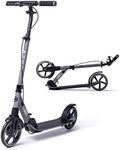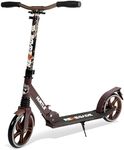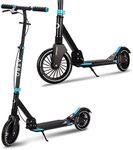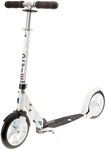Buying Guide for the Best Adult Kick Scooters
Choosing the right adult kick scooter can make your daily commute, exercise routine, or leisure rides much more enjoyable and efficient. The key is to match the scooter’s features to your intended use, comfort preferences, and the type of terrain you’ll be riding on. By understanding the main specifications, you’ll be able to find a scooter that feels just right for your needs and lifestyle.Wheel SizeWheel size refers to the diameter of the scooter’s wheels, usually measured in millimeters. This is important because it affects how smooth and fast your ride will be. Smaller wheels (around 120-145mm) are lighter and more agile, making them good for short, smooth rides or quick turns, but they can struggle with bumps and cracks. Medium wheels (around 180-200mm) offer a balance between speed and comfort, suitable for most city commutes. Larger wheels (200mm and above) roll over rough surfaces more easily and provide a smoother ride, making them ideal for longer distances or uneven terrain. To pick the right wheel size, think about where you’ll ride most often: smooth pavements, city streets, or rougher paths.
Deck Size and HeightThe deck is the part of the scooter you stand on, and its size and height can affect your comfort and stability. A wider and longer deck gives you more space to stand and shift your feet, which is helpful for longer rides or larger riders. A higher deck can make it harder to push, while a lower deck is easier on your legs but may scrape on uneven ground. If you have larger feet or plan to ride for extended periods, look for a spacious, low-to-the-ground deck for comfort and efficiency.
Handlebar Height and AdjustabilityHandlebar height determines how comfortable and ergonomic your riding position will be. Adjustable handlebars let you set the height to match your body, which is important for reducing strain on your back and arms. If the handlebars are too low, you’ll hunch over; if they’re too high, you’ll lose control. Ideally, the handlebars should be around waist to hip height when you stand on the deck. Choose a scooter with adjustable handlebars if you’re unsure or if multiple people will use it.
Weight CapacityWeight capacity tells you the maximum rider weight the scooter can safely support. This is crucial for safety and durability. Most adult scooters support at least 220 lbs (100 kg), but some heavy-duty models can handle more. Always check this spec to ensure the scooter is suitable for your body weight, especially if you’re on the heavier side or plan to carry a backpack or groceries while riding.
Folding Mechanism and PortabilityMany adult kick scooters are designed to fold for easy carrying and storage. The folding mechanism’s ease of use and the scooter’s overall weight affect how portable it is. If you need to carry your scooter on public transport or up stairs, look for a lightweight model with a simple, secure folding system. If portability isn’t a concern, you can focus more on ride comfort and stability.
SuspensionSuspension refers to shock-absorbing features that help smooth out bumps and vibrations from rough surfaces. Some scooters have front or rear suspension, or both, while others have none. Suspension adds comfort, especially if you’ll be riding on uneven pavement or rough paths, but it can also add weight and complexity. If you mostly ride on smooth surfaces, you may not need suspension; if comfort is a priority or your routes are bumpy, look for a scooter with built-in suspension.
Braking SystemThe braking system is how you slow down or stop the scooter. Most adult kick scooters use a rear fender brake, which you press down with your foot, while some have hand-operated brakes for extra stopping power. Rear fender brakes are simple and reliable for most uses, but hand brakes can be helpful for faster rides or hilly areas. Consider your riding speed and environment when choosing the braking system that feels safest and most comfortable for you.



















